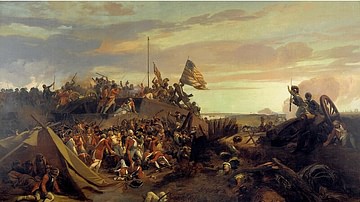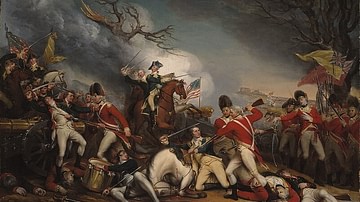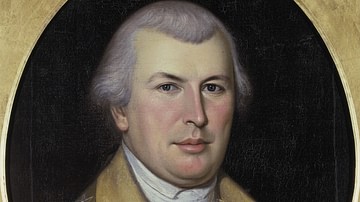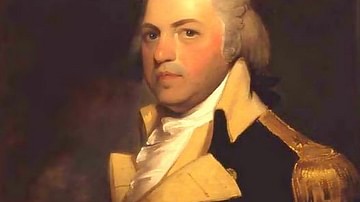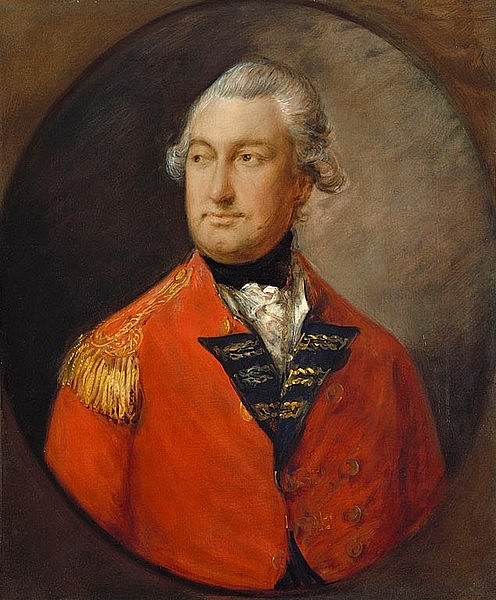
Charles Cornwallis (1738-1805), 1st Marquess and 2nd Earl Cornwallis, was a British military officer and statesman best known for surrendering to George Washington at the Siege of Yorktown, the final decisive engagement of the American Revolutionary War (1775-1783). After the war, Cornwallis went on to serve in administrative posts in India and Ireland.
Early Life
Charles Cornwallis was born on 31 December 1738, in Grosvenor Square in London, England, the scion of an old and distinguished family. His ancestor, Frederick Cornwallis, had fought for the Royalists in the English Civil Wars (1642-1651) and had even joined King Charles II of England in exile; for his loyal service to the Stuarts, Frederick was made Baron Cornwallis in 1661 following the restoration of Charles II to the English throne. Members of the Cornwallis family would go on to prosper in various positions across the British Empire. Charles' uncle, Edward Cornwallis, served as the colonial governor of Nova Scotia and founded the town of Halifax, while another uncle, Frederick, was Archbishop of Canterbury.
Charles was the eldest of six children born to Charles, 1st Earl Cornwallis, and his wife Elizabeth Townshend. As a youth, he was educated at Eton College, where he sustained a permanent eye injury during a game of field hockey, accidentally inflicted by Shute Barrington, future bishop of Durham. In December 1757, shortly before his 19th birthday, he was commissioned in the British Army as an ensign in the Grenadier Guards. Hoping to broaden his understanding of military matters, he traveled across Europe under the tutelage of a Prussian officer before enrolling in a military academy in Turin, Italy. The young Cornwallis was described as "an English aristocrat of the finest type…enlightened, tolerant, and humane; contemptuous of money and indifferent to the outward badges of honour…a living and most attractive example of antique and single-minded patriotism" (quoted in Boatner, 285).
Upon completing his studies at Turin, Cornwallis learned that his regiment was being deployed to fight in the ongoing Seven Years' War (1756-1763). Cornwallis served in Germany in the allied army commanded by Prince Ferdinand of Brunswick-Wolfenbüttel. He first saw action at the Battle of Minden (1 August 1759) in which the British and their German allies thwarted an attempted French invasion of Hanover; it was during this action that the father of Marquis de Lafayette, one of Cornwallis' future battlefield opponents, was killed. After Minden, Cornwallis purchased a captaincy in the 85th Regiment of Foot and briefly returned to England where he won election to the House of Commons in January 1760.
Returning to the battlefront, Cornwallis was promoted to lieutenant colonel and assumed command of his regiment. He saw heavy fighting at the Battle of Villinghausen (15-16 July 1761), where he was noted for his gallantry, and participated in the Battle of Wilhelmsthal (24 June 1762). During these campaigns, Cornwallis met and befriended fellow British officers Henry Clinton and William Phillips, both of whom would also serve as generals during the American Revolution. Cornwallis fought in several more minor engagements in Germany before the end of the war the following year.
Politics & Marriage
In June 1762, Cornwallis became the 2nd Earl Cornwallis upon the death of his father and was elevated to the House of Lords. As a member of Parliament, Cornwallis became a Whig and was politically mentored by Lord Rockingham, a leading Whig politician and eventual prime minister. The major political issue of the day was the rising tension between Parliament and the Thirteen Colonies of British North America. Parliament had attempted to impose direct taxes on the colonies to help pay for the recent war, only for many colonists to refuse to pay; the colonists argued that since no Americans were represented in Parliament, Parliament had no constitutional authority to tax them. Cornwallis and the other so-called 'Rockingham Whigs' were generally sympathetic towards the plight of the American colonists. In 1765, Cornwallis was one of only five British peers to vote against the passage of the Stamp Act, which the colonists considered one of the most egregious affronts to their liberties.
Despite his opposition to the colonial policy of the king, Cornwallis enjoyed the favor of King George III of Great Britain (r. 1760-1820). In August 1765, he was selected as the king's aide-de-camp and was promoted to colonel of the 33rd Foot the following year. On 14 July 1768, Cornwallis married Jemima Tullekin Jones, daughter of a British colonel. Their marriage appears to have been a happy one and Cornwallis absented himself from politics to spend more time with his wife at their new home in Culford, Suffolk. The couple would ultimately have two children: Mary (1769-1840) and Charles (1774-1823).
Fighting the Americans
On 19 April 1775, long-simmering tensions between the Thirteen Colonies and Great Britain finally boiled over when the first shots of the American Revolution were fired at the Battles of Lexington and Concord. Although Cornwallis was still sympathetic toward the colonies, he valued service to his country over the grievances of the Americans. He accepted the rank of major general and, in February 1776, sailed for North America in command of 2,500 troops. He arrived off the coast of South Carolina and joined forces with his old army comrade General Henry Clinton to launch an attack on Charleston, the largest city in the American South. On 28 June 1776, the British attempted an amphibious landing of Charleston harbor but were beaten back by Patriot troops under Colonel William Moultrie at the Battle of Sullivan's Island.
Frustrated in their attempts to open a southern theater of war, Clinton and Cornwallis sailed to New York Harbor to link up with the main British expeditionary force under commander-in-chief Sir William Howe. Cornwallis played a pivotal role at the Battle of Long Island (27 August 1776), commanding the 'reserve' force that marched behind Clinton's vanguard, moving through the Jamaica Pass to outflank the American position. The flanking maneuver succeeded, and the American line quickly crumbled. During the final part of the battle, Cornwallis' grenadiers held out against a resilient Maryland regiment that tried six times to break through the wall of British soldiers. The battle resulted in a decisive British victory and led to the British capture of New York City on 15 September.
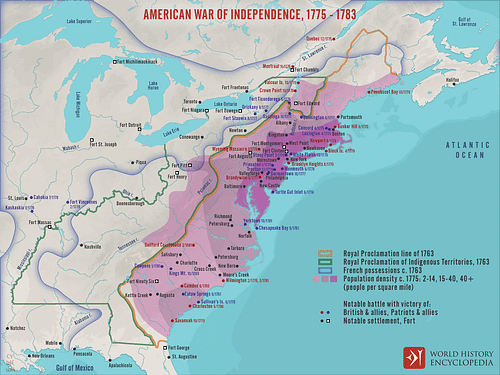
The British forces then began their pursuit of the American Continental Army in the New York and New Jersey Campaign. Cornwallis commanded a detachment at the Battle of Fort Washington (16 November 1776), which resulted in over 2,800 American prisoners of war and the expulsion of Continental soldiers from Manhattan Island. Howe then sent Cornwallis into New Jersey with 10,000 men to chase down American General George Washington, whose army was rapidly being whittled down by disease and desertion. After securing the abandoned Fort Lee on the New Jersey Palisades, Cornwallis pursued Washington through the winter slush and mud; convinced of an easy victory, Cornwallis quipped that he would soon catch Washington in a similar manner to how "a hunter bags a fox" (McCullough, 253).
But it would not be so easy. In early December, Washington crossed the Delaware River into Pennsylvania. Howe, satisfied that the depleted Continental Army no longer posed a threat, ordered his army into winter quarters; he even granted Cornwallis leave to return to England to visit his wife, whose health was failing. But Washington soon shocked everyone when he led his army back across the Delaware, surprising and defeating a Hessian garrison at the Battle of Trenton (26 December 1776). Alarmed, Howe canceled Cornwallis' leave and ordered him after Washington. With 8,000 men, Cornwallis marched the 50 (80 km) miles to Trenton, Washington's last known location, where he found the Continental Army in a defensive position behind Assunpink Creek. On 2 January 1777, Cornwallis' troops assaulted the American position but were unable to break through before darkness fell. As Cornwallis' men settled down for the night, intending to renew the attack the next morning, Washington's army slipped away, marching around Cornwallis' army to strike the British rearguard at the Battle of Princeton (3 January). In response to these defeats, Howe withdrew his army from much of New Jersey.
Capture of Philadelphia
Cornwallis received much of the blame for the defeats at Trenton and Princeton. His erstwhile friend Clinton believed that Cornwallis had given up a golden opportunity to destroy Washington's army, accusing the earl of "the most consummate ignorance I ever heard of [in] any officer above a corporal" (quoted in Boatner, 287). Much of the British high command shared Clinton's scathing opinion, leaving Cornwallis aware that he had to redeem his reputation. He would have his chance in the Philadelphia Campaign, launched by Howe in July 1777 to seize the United States capital of Philadelphia. At the Battle of Brandywine (11 September 1777), Cornwallis' division outflanked the right wing of the Continental Army, a maneuver that turned the American flank and helped win the battle for the British. On 26 September, his division was the first part of the British army to enter undefended Philadelphia in triumph.
In January 1778, Cornwallis finally got to take his leave of absence to England to visit his still ailing wife and received a promotion to lieutenant general while there. Upon his return to North America in April, he also discovered that he was now second-in-command of the British army; Howe had resigned as commander-in-chief, a post that had fallen to Clinton. The entry of France into the war as a U.S. ally prompted Clinton to begin planning an evacuation of Philadelphia so that he could consolidate his forces in Manhattan. On 18 June 1778, the British army marched out of Philadelphia and began a slow retreat through New Jersey, with Washington's army in close pursuit. On 28 June, the last elements of Cornwallis' division were preparing to leave Monmouth Court House, New Jersey, when they were attacked by the vanguard of the Continental Army. The Americans botched their assault, however, giving Cornwallis time to turn the rest of his division around and launch a counterattack. Cornwallis fought bravely at the Battle of Monmouth, personally leading the elite Coldstream Guards into action, although the battle ended in a draw.
After Monmouth, the British successfully returned to Manhattan Island, and the war in the north settled into a stalemate. Cornwallis took advantage of the calm to once again visit England in December 1778 and was by Jemima's bedside when she died in February 1779. Distraught, Cornwallis lingered in England for several more months before returning to North America in July, to help develop Britain's new 'southern strategy'; this called for the British to shift their military focus to the resource-rich American South, the capture of which was believed to bring about an end to the war. In March 1780, Clinton and Cornwallis led 10,000 men back to Charleston, capturing both the city and its 5,000-man garrison after less than two months of siege. The Siege of Charleston, arguably the worst American defeat of the war, gave the British a base from which they could begin their conquest of the South.
Southern Campaign & Yorktown
During the Siege of Charleston, relations between Clinton and Cornwallis broke down; they were no longer on speaking terms by the end of it. Nevertheless, when Clinton returned to Manhattan with the bulk of the army in June 1780 – he needed to keep an eye on Washington, whose main army was still in New Jersey – he left Cornwallis behind with 3,000 men, entrusting the earl to complete the pacification of South Carolina. Cornwallis immediately set about accomplishing this task, establishing a supply depot at Camden, setting up military outposts across the state, and recruiting Loyalist militias. On 16 August 1780, Cornwallis won a major victory over an American army at the Battle of Camden, further solidifying his control of South Carolina. With a disinterested Clinton failing to send instructions, Cornwallis was free to command as he pleased and likely believed that he would soon win the credit for snuffing out the American rebellion himself.
But as Cornwallis should have known by now, victory would not come so easily. As Cornwallis tightened his grip over South Carolina, Patriot militias began popping up in the backcountry, striking British outposts, ambushing military patrols, and disrupting Cornwallis' supply line. The earl sent his own Loyalist militias after these Patriots, sparking a small civil war in South Carolina's backcountry that culminated in the defeat of the Loyalists at the Battle of Kings Mountain (7 October 1780). Several months later, the British suffered another humiliation when a detachment under Lt. Colonel Banastre Tarleton was defeated at the Battle of Cowpens (17 January 1781). Both engagements significantly weakened the British hold on the South. Cornwallis then marched into North Carolina to deal with the southern American army under General Nathanael Greene, clashing with him at the Battle of Guilford Court House (15 March 1781). Although Cornwallis won the battle, he lost 25% of his men and failed to destroy Greene's army.
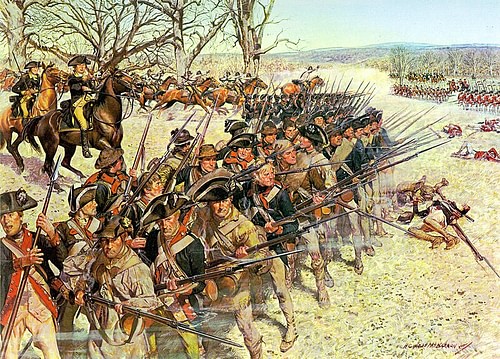
After briefly pausing at Wilmington, North Carolina, Cornwallis decided to continue marching north and invade Virginia, where his old friend William Phillips was leading another British army; Cornwallis hoped that by adding his strength to Phillips', they could conquer Virginia, which would in turn end Patriot resistance in the Carolinas. After linking up with Phillips' army (Phillips himself died of disease a week before Cornwallis' arrival), Cornwallis proceeded to terrorize the Virginian countryside, all the while skirmishing with a small American army under Marquis de Lafayette. But Clinton, who was growing frustrated with Cornwallis' setbacks, ordered his second-in-command to choose a position on the Virginia Peninsula and wait to be picked up by the Royal Navy and brought back to Manhattan. Exasperated, Cornwallis did as he was instructed and moved his army to Yorktown.
It was here that his army was soon trapped. Lafayette kept him bottled up long enough for Washington to arrive at the head of a Franco-American army and lay siege. At the same time, a French fleet under the Comte de Grasse defeated British warships at the Battle of the Chesapeake, cutting off Cornwallis' escape route by sea. On 19 October 1781, after a three-week siege, Cornwallis surrendered to Washington. Not wishing to undergo the humiliation, Cornwallis did not attend the surrender ceremony, claiming illness, and sent General Charles O'Hara to offer his sword to Washington in his stead. Cornwallis was briefly kept as a prisoner of war before being exchanged and sent back to Britain on parole.
Governor of India
After being granted parole, Cornwallis returned to London in January 1782 alongside American turncoat Benedict Arnold, both of whom were cheered by the gathered spectators. Cornwallis proved to be one of the few British field commanders whose career was not ruined by the war; although Clinton and Banastre Tarleton both wrote pamphlets in which they blamed Cornwallis for the defeat, the earl still enjoyed the favor of King George III. He was named ambassador to the Prussian court in 1785, and the following year, he became a Knight of the Order of the Garter. In 1786, Cornwallis was appointed Governor-General of India and spent his tenure implementing legal and administrative reforms.
He sought to improve the imperial bureaucracy in India by cracking down on corruption, which he did by increasing the salaries of British East India Company employees, valuing meritocracy over nepotism, and forbidding civil servants from engaging in private business. However, he also introduced segregation into India's administrative system by excluding non-whites from holding office. Cornwallis set up new circuit courts, established a mint in Calcutta, and outlawed the practice of child slavery. These provisions were solidified in the so-called Cornwallis Code of 1793. Cornwallis also oversaw the third of the Anglo-Mysore Wars (1790-1792), in which he led the East India Company to victory against Tipu Sultan. For this, he was created Marquess Cornwallis in 1792.

Later Career
Cornwallis sailed for England in October 1793, several months after Great Britain's entry into the French Revolutionary Wars (1792-1802). He was appointed master of the ordinance in 1794 and was tasked with overseeing Britain's coastal defenses, building up supply depots, and improving the army's infrastructure. In June 1798, he was appointed Lord Lieutenant of Ireland in response to the Irish Rebellion of 1798, which had broken out the month before. The rebels, known as the United Irishmen, were supported by the French Republic; in August, a 2,000-man French expeditionary force under General Jean Humbert landed in County Mayo to aid the Irish guerilla fighters. On 8 September, Cornwallis defeated the French troops and Irish rebels at the Battle of Ballinamuck; after the battle, Cornwallis reconsolidated British authority in Ireland, rounding up and summarily executing rebel leaders. His harsh suppression of the rebellion won him few friends, and he became the target of a failed assassination attempt in Dublin in 1799.
In March 1802, Cornwallis acted as British plenipotentiary to France and signed the Treaty of Amiens, which ended nearly a decade of warfare with the French Republic; the treaty, however, offered only a brief respite before war with Napoleonic France renewed in 1803. In 1805, Cornwallis was once again appointed Governor-General of India. He arrived in July to take up his post but soon fell ill and died on 5 October 1805 at age 66. He was buried at Ghazipur in northern India. His son, Charles, became the 2nd Marquess Cornwallis, but the marquessate became extinct upon the son's death in 1823.






